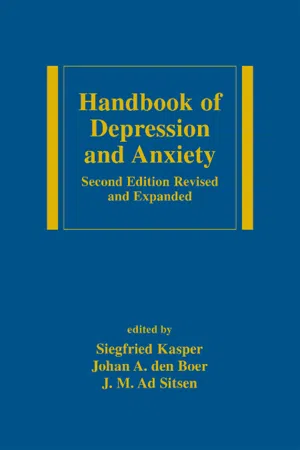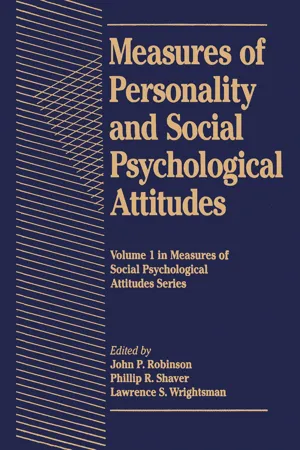Psychology
Self Report Scales
Self-report scales are assessment tools used to gather information directly from individuals about their thoughts, feelings, and behaviors. These scales typically consist of questionnaires or surveys that ask respondents to rate or describe their experiences. They are commonly used in psychological research and clinical practice to measure various constructs such as personality traits, mental health symptoms, and attitudes.
Written by Perlego with AI-assistance
Related key terms
1 of 5
5 Key excerpts on "Self Report Scales"
- eBook - PDF
Handbook of Depression and Anxiety
A Biological Approach, Second Edition
- Siegfried Kasper, Johan A. den Boer, J.M. Ad Sitsen(Authors)
- 2003(Publication Date)
- CRC Press(Publisher)
These errors may be partially compensated for by combining observer-rated scales with self-rated scales [3,9,24]. In self-rated instruments, patients can themselves classify past or current behavior and experience on the basis of fixed rating scales. Self-rated scales have the further advantage that their use is very economical for the assessor and eliminates observer bias. However, their use also introduces the disadvantage that conscious or un-conscious tendencies to falsify responses (e.g., tendencies to exaggerate or conceal symp-toms, the positive response bias, social desirability effects) will have a greater impact on patients and are only partially detectable through use of control scales (so-called lie detec-tor scales). Apart from a few scales measuring current mental state which, as with the Self-Report Symptom Inventory (SCL-90), record a very broad spectrum of psychopathological symptoms, most self-rated scales focus on specific aspects of disturbance of subjective experience (Table 1). Examples are inventories of physical and systemic complaints [25,26], depressive symptom scales [26–28], or measures of general subjective well-being Table 1 Examples of Clinical Self-Rated Procedures Domains Procedure Abbreviation Refs. Global psychopathology Self-Report Symptom Inventory SCL-90 30 SCL-90R 31 Depression Depressivita ¨ts-Skala (De-DS 26 pressive Symptom Scale) Befindlichkeits-Skala (Mental Bf-S 26 State Scale) Beck Depression Inventory BDI 32 Anxiety disorders Self-Rating Anxiety Scale SAS 33, 31 State-Trait Angst-Inventar STAI 34 (State-Trait Anxiety Inven-tory) Obsessive-compulsive Hamburger Zwangsinventar HZI 35, 36 symptoms (Hamburg Compulsive Inven-tory) Alcoholism Mu ¨nchner Alkoholismustest MALT 37 (Munich Alcoholism Test) Source : Ref. 6. Scales 797 [26,29]. One of the advantages of this approach is that the quantity of items is limited, a particular strength where severely disturbed psychiatric patients are concerned. - eBook - PDF
- Rocio Fernandez-Ballesteros(Author)
- 2002(Publication Date)
- SAGE Publications Ltd(Publisher)
Furthermore, the technique lends itself to high quality standardiza-tion. With objective scoring procedures, responses can be compared with high reliability to various large samples of interest, a normative comparison facilitated by the efficiency of the data collection. Finally, self-report offers an opportunity to directly measure the phenomenol-ogy or subjective experience of the respondent. For most constructs, subjective experience is 866 Self-Report Questionnaires a critical part of the concept; it is difficult to imagine how someone could be given psycholo-gical descriptors such as ‘unhappy’ or ‘obsessive’ without a glimpse into their personal experience. Self-report provides an objective, standardized method for capturing these experiences (in contrast to unstructured approaches such as interviews or free associations), while less direct assessment techniques (such as projective, obser-vational, or psychophysiological methods) can at best only allow inferences about phenomenology. Thus, self-report holds a vital place in the assessment of virtually any construct in person-ality and psychopathology. However, there have also been concerns expressed over the accuracy of self-reported information as an indication of psychological status. One source of distortion may arise from efforts to deceive the recipient of the information; for example, examinees may attempt to appear either better adjusted or more poorly adjusted than is actually the case. A second source may arise from limited insight or self-deception; examinees may genuinely believe that they are doing quite well or quite poorly, but this belief might be at odds with the impression of objective observers. A third source of distortion can also arise from carelessness, confusion, or indifference in taking a test; examinees who answer questions with little reflection (or even randomly) may yield results that do not accurately mirror their experiences. - eBook - PDF
- John Hunsley, Catherine M. Lee(Authors)
- 2017(Publication Date)
- Wiley(Publisher)
Over the past century, psychologists have constructed literally thousands of measures of individual differences. Many of these mea- sures are designed to assess personality traits, which psychologists define as consistencies in behaviour, emotions, and attitudes that are evident across situations and across time. Personality theorists and researchers work to examine the influences of genetics and life experi- ences on the development of traits (Mischel, 2004) and how traits are expressed in everyday life (Hampson, 2012). Clinical psychologists are active in both researching personality traits and in assessing person- ality traits for clinical purposes. As you may know from taking a Assessment: Self-Report and Projective Measures Introduction The Person-Situation Debate Self-Presentation Biases Developing Culturally Appropriate Measures The Clinical Utility of Self-Report and Projective Measures Self-Report Personality Measures MMPI-2 and MMPI-A Other Clinical Measures of Personality Functioning Self-Report Checklists of Behaviours and Symptoms Achenbach System of Empirically Based Assessment SCL-90-R Outcome Questionnaire 45 Beck Depression Inventory-II Children’s Depression Inventory 2 Projective Measures of Personality Rorschach Inkblot Test Summary and Conclusions 170 CHAPTER 8 Assessment: Self-Report and Projective Measures personality theory course, personality measures vary in the scope of the constructs they are designed to assess. Some are intended to measure very broad constructs such as extraver- sion or neuroticism; others focus on highly specific constructs such as perfectionism or moti- vation for academic tasks. Most personality measures are based on self-report data and are often called objective personality tests because they can be scored objectively (i.e., the same scoring system is always used). - eBook - PDF
- C. G. Costello, Hugh L. Freeman(Authors)
- 2016(Publication Date)
- Pergamon(Publisher)
In the next chapter of this book, Infrequently Used Assessment Techniques, we shall be considering some of the lesser known measuring devices in psychology which may replace the questionnaire approach to the assessment of personality. Rating Scales Rating scales are often used for assessments within psychiatric settings. We shall therefore consider briefly some of the problems connected with them. There are a number of types of rating scales. The most common are: (1) Numerical rating scales in which the rater assigns to each person a numerical value for each trait. He may, for instance, assign to a person on a trait of honesty a score of 1, meaning that the person is completely dishonest, or a score of 7, meaning that he is most honest. (2) Graphic rating scales, in which a judgment is made by making a mark or a line, rather than by giving the subject a number. (3) Check list rating scale, in which a number QUESTIONNAIRES AND RATING SCALES 233 of trait names, such as selfish, cruel, etc., are given to the judges, and the judges have to check every word that they feel applies to the subject being rated. (4) Forced choice rating scales, in which the rater is required to choose between two favorable qualities, or between two unfavorable qualities, when rating a person. In some of the forced rating scales, the rater is presented with a tetrad which is composed of two popular trait descriptions and two unpopular ones. One of the popular ones and one of the unpopular ones are known to be valid on the basis of empirical data, for indicating the trait dimension to be evaluated, but the others are not. The rater has to choose the one of the four qualities in the tetrad that he thinks describes the person best, and also the one that describes him least. The rater may know which qualities are popular or unpopular, but he is unlikely to know which ones are valid. - eBook - PDF
Measures of Personality and Social Psychological Attitudes
Measures of Social Psychological Attitudes
- John P. Robinson, Phillip R. Shaver, Lawrence S. Wrightsman, John P. Robinson, Phillip R. Shaver, Lawrence S. Wrightsman(Authors)
- 2013(Publication Date)
- Academic Press(Publisher)
CHAPTER 1 Criteria for Scale Selection and Evaluation John P. Robinson, Phillip R. Shaver; and Lawrence S. Wrightsman The original idea for this handbook of attitude and personality measures came from Robert Lane, a political scientist at Yale University. Like most social scientists, Lane found it difficult to keep up with the proliferation of social attitude measures. In the summer of 1958, he attempted to pull together a broad range of scales that would be of interest to researchers in the field of political behavior. Subsequently, this work was continued and expanded at the Survey Research Center of the University of Michigan under the general direction of Philip Converse, with support from a grant by the National Institute of Mental Health. The result was a three-volume series, the most popular of which was the last, Measures of Social Psychological Attitudes. That is the focus of our first update of the original volumes. Readers will note several differences between this work and its predecessors. Most important, we have given responsibility for each topic to experienced and well-known researchers in each field rather than choosing and evaluating items by ourselves. These experts were also limited to identifying the 10 or 20 most interesting or promising measures in their area, rather than covering all available instruments. This new structure has resulted in more knowledgeable review essays, but at the expense of less standardized evaluations of individual instruments. There are many reasons for creating a volume such as this. Attitude and personality measures are likely to appear under thousands of book titles, in dozens of social science journals, in seldom circulated dissertations, and in the catalogues of commercial pub- lishers, as well as in undisturbed piles of manuscripts in the offices of social scientists. This is a rather inefficient grapevine for the interested researcher.
Index pages curate the most relevant extracts from our library of academic textbooks. They’ve been created using an in-house natural language model (NLM), each adding context and meaning to key research topics.




